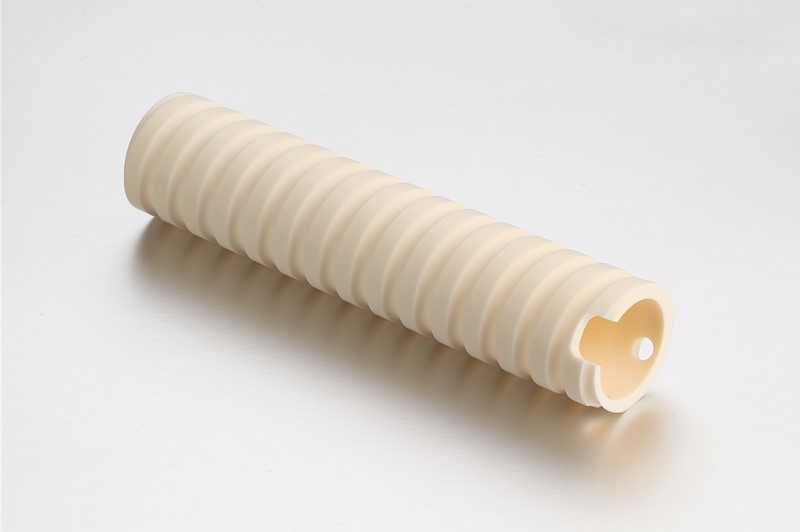Alumina Ceramics (Al2O3)
Description
Reviews
Alumina is the most widely used materials in oxide materials, especially whose purity is higher than 99.5%. These ceramic materials have superb material characteristics such as high hardness, high wear resistant, high mechanical strength, perfect thermostability, antioxidation stability, high chemical-resistance, high electrical insulation etc. High purity alumina is one of the most important ceramic materials. Alumina part is substitute for plastics, metals or other conventional materials. Alumina ceramic part is widely used in a wide range of industrial fields such as Machinery, Textile, Petroleum, Chemical, Metallurgy and Electronic industries.
| 95% Alumina | ||||||
| Mechanical Characteristic | Colour | Ivory | ||||
| Density | 3.6 | g/cm3 | ||||
| Bending Strength | 300 | MPa | ||||
| Compressive Strength | 2,300 | MPa | ||||
| Elastic Modulus | 320 | GPa | ||||
| Fracture Toughness | 3~4 | MPa m1/2 | ||||
| Weber Coefficient | 12 | m | ||||
| Vickers Hardness | 1,400 | HV 0.5 | ||||
| Thermal Characterics | Coefficient of Line Thermal Expansion | 7~ 8 | 10-6 K-1 | |||
| Thermal Conductivity | 20 | W/mK | ||||
| Thermal Shock Resistance (Put in Water) | 250 | ∆T °C | ||||
| Max Working Temperature | 1,500 | °C | ||||
| Electrical Characteristics | Volume Resistance at 20℃ | >1014 | Ωcm | |||
| Dielectric Strength | 15×106 | V/m | ||||
| Dielectric Constant | 9 | εr | ||||
| One MHZ Dielectric Loss Angle at 20℃ | 0.0004 | tanδ | ||||
| Chemical Characteristics | Nitric Acid (60%) 90°C | 0.1 | WT Loss mg/cm2/day | |||
| Sulphuric Acid (95%) 95°C | 0.3 | |||||
| Caustic Soda (30%) 80°C | 0.9 | |||||
| 99% Alumina | ||||||
| Mechanical Characteristics | Colour | light yellow | ||||
| Density | 3.8 | g/cm3 | ||||
| Bending Strength | 310 | MPa | ||||
| Compressive Strength | 2,200 | MPa | ||||
| Elastic Modulus | 340 | GPa | ||||
| Fracture Toughness | 3~4 | MPa m1/2 | ||||
| Weber Coefficient | 12 | m | ||||
| Vickers Hardness | 1,600 | HV 0.5 | ||||
| Thermal Characterics | Coefficient of Line Thermal Expansion | 7~8 | 10-6 K-1 | |||
| Thermal Conductivity | 29 | W/mK | ||||
| Thermal Shock Resistance (Put in Water) | 200 | ∆T °C | ||||
| Max Working Temperature | 1,600 | °C | ||||
| Electrical Characteristics | Volume Resistance at 20℃ | >1014 | Ω·cm | |||
| Dielectric Strength | 15×106 | V/m | ||||
| Dielectric Constant | 10 | εr | ||||
| One MHZ Dielectric Loss Angle at 20℃ | 0.0002 | tanδ | ||||
| Chemical Characteristics | Nitric Acid (60%) 90°C | 0.1 | WT Loss mg/cm2/day | |||
| Sulphuric Acid (95%) 95°C | 0.34 | |||||
| Caustic Soda (30%) 80°C | 0.95 | |||||
|
High Purity Microcrystalline Alumina (Al2O3> 99.7%)
|
||
|
Colour
|
White, Ivory
|
|
|
Density
|
3.9
|
g/cm3
|
|
Bending Strength
|
360
|
MPa
|
|
Compressive Strength
|
3,900
|
MPa
|
|
Elastic Modulus
|
390
|
GPa
|
|
Shock Strength
|
5.2
|
MPa m1/2
|
|
Weber Coefficient
|
12
|
m
|
|
Vickers Hardness
|
2,000
|
HV 0.5
|
|
Thermal Expansion Coefficient
|
5.5 - 8.4
|
10-6 K-1
|
|
Thermal Conductivity
|
28
|
W/mK
|
|
Thermal Shock Resistance Stability
|
280
|
∆T °C
|
|
Max Working Temperature
|
1,700
|
°C
|
|
Volume Resistance at 20℃
|
>1015
|
Ωcm
|
|
Electrolyte Strength
|
30
|
kV/mm
|
|
Dielectric Constant
|
10
|
εr
|
|
One MHZ Dielectric Loss Angle at 20℃
|
0.0005
|
tanδ
|
The chart is intended to illustrate typical properties of steatite ceramic. Engineering data is representative. Property values vary somewhat with method of manufacture, size, and shape of part.

